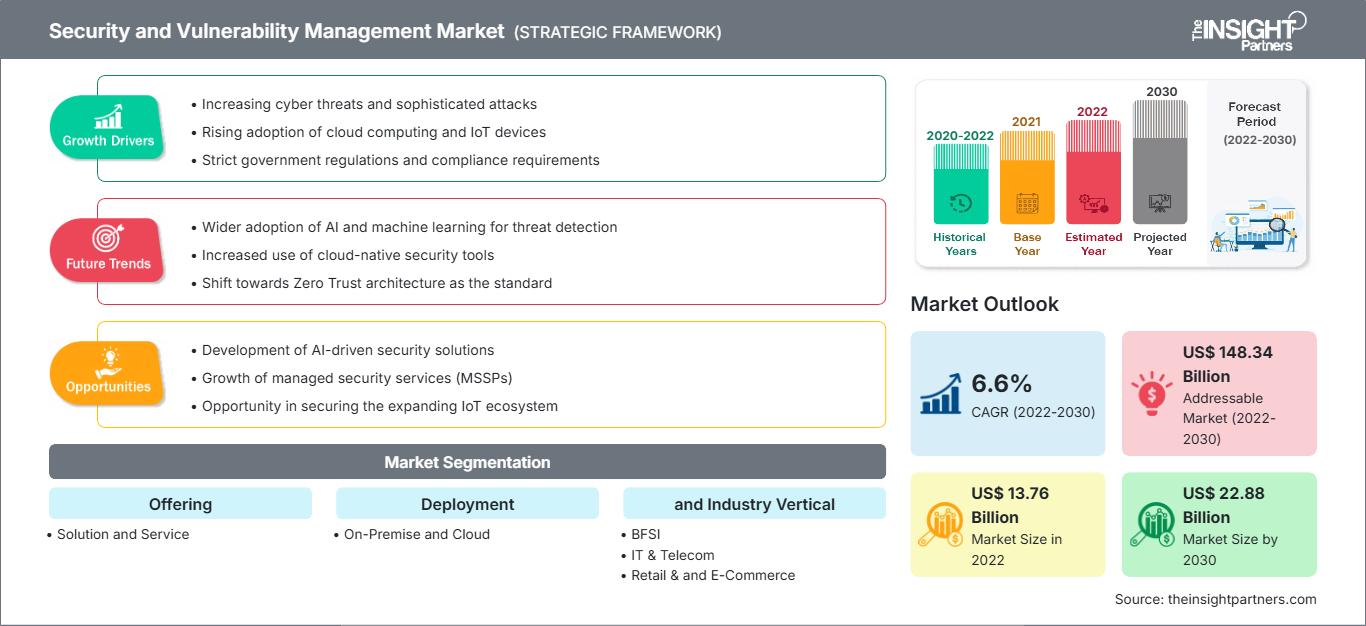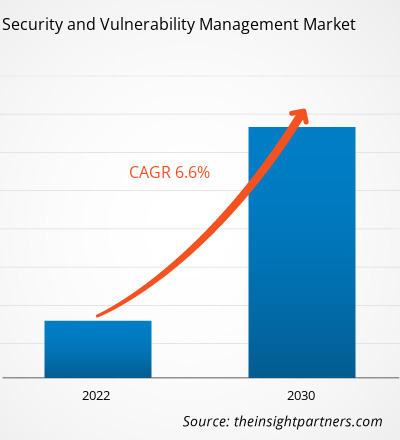[Rapporto di ricerca] Si prevede che il mercato della gestione della sicurezza e delle vulnerabilità crescerà da 13,76 miliardi di dollari nel 2022 a 22,88 miliardi di dollari entro il 2030; si stima che il mercato registrerà un CAGR del 6,6% dal 2022 al 2030.
Prospettiva dell'analista:
Il rapporto include le prospettive di crescita dovute alle attuali tendenze del mercato della gestione della sicurezza e delle vulnerabilità e al loro impatto prevedibile durante il periodo di previsione. Il crescente numero di attacchi informatici e violazioni dei dati in tutto il mondo sono tra i fattori che sostengono il mercato. Si prevede che i crescenti investimenti in soluzioni basate sull'intelligenza artificiale e l'espansione dei settori BFSI e sanitario stimoleranno ulteriormente il mercato durante il periodo di previsione. Anche le severe normative governative relative alla sicurezza informatica e alla riservatezza dei dati favoriranno il mercato. Inoltre, l'integrazione di tecnologie moderne come intelligenza artificiale, apprendimento automatico, strumenti di analisi dei dati e cloud storage creerà probabilmente opportunità di crescita per il mercato della gestione della sicurezza e delle vulnerabilità nei prossimi anni.
Panoramica di mercato:
La sicurezza è la risorsa più preziosa di un'organizzazione, che richiede il contributo sia della tecnologia che della formazione. Le vulnerabilità sono causate da guasti nei sistemi, che potrebbero portare ad accessi non autorizzati a informazioni private. La gestione della sicurezza e delle vulnerabilità è il processo di identificazione, classificazione, mitigazione e correzione delle vulnerabilità nell'hardware o nel software di rete. I dati cruciali ottenuti dalla valutazione delle vulnerabilità vengono utilizzati dai team di sicurezza per correggere le vulnerabilità nelle loro reti, facilitando così le attività di valutazione del rischio e mitigazione delle minacce. Un'impennata dei crimini informatici e l'aumento degli investimenti nei processi di sicurezza informatica probabilmente guideranno la crescita del mercato della gestione della sicurezza e delle vulnerabilità nel prossimo futuro.
Personalizza questo rapporto in base alle tue esigenze
Potrai personalizzare gratuitamente qualsiasi rapporto, comprese parti di questo rapporto, o analisi a livello di paese, pacchetto dati Excel, oltre a usufruire di grandi offerte e sconti per start-up e università
Mercato della gestione della sicurezza e della vulnerabilità: Approfondimenti strategici

- Ottieni le principali tendenze chiave del mercato di questo rapporto.Questo campione GRATUITO includerà l'analisi dei dati, che vanno dalle tendenze di mercato alle stime e alle previsioni.
Potrai personalizzare gratuitamente qualsiasi rapporto, comprese parti di questo rapporto, o analisi a livello di paese, pacchetto dati Excel, oltre a usufruire di grandi offerte e sconti per start-up e università
Mercato della gestione della sicurezza e della vulnerabilità: Approfondimenti strategici

- Ottieni le principali tendenze chiave del mercato di questo rapporto.Questo campione GRATUITO includerà l'analisi dei dati, che vanno dalle tendenze di mercato alle stime e alle previsioni.
Driver del mercato della gestione della sicurezza e delle vulnerabilità:
Il crescente numero di attacchi informatici e violazioni dei dati alimenta il mercato della gestione della sicurezza e delle vulnerabilità
Secondo un rapporto dell'AAG pubblicato a febbraio 2024, il 43% delle aziende del Regno Unito subirà attacchi informatici nel 2022, registrando un aumento di circa il 32% rispetto al 2020. Ciò stimola la domanda di soluzioni e servizi per la gestione della sicurezza e delle vulnerabilità tra i consumatori per proteggere i dati sensibili e i sistemi critici dagli attacchi informatici. Inoltre, queste soluzioni vengono utilizzate anche per identificare e affrontare le vulnerabilità che aiutano gli utenti a mitigare i rischi legati alle violazioni della sicurezza e a proteggere dati e sistemi sensibili.
Segmentazione e ambito del rapporto:
L'analisi del mercato della gestione della sicurezza e delle vulnerabilità è stata condotta considerando i seguenti segmenti: offerta, distribuzione e settore. In base all'offerta, il mercato è segmentato in soluzioni e servizi. In termini di implementazione, il mercato della gestione della sicurezza e delle vulnerabilità è suddiviso in on-premise e cloud. In base al settore, il mercato è suddiviso in BFSI, IT e telecomunicazioni, vendita al dettaglio ed e-commerce, sanità, pubblica amministrazione e servizi di pubblica utilità e altri. Per regione, il mercato è segmentato in Nord America, Europa, Asia Pacifico (APAC), Medio Oriente e Africa (MEA) e Sud America (SAM).
Analisi Segmentale:
In base al settore, il mercato della gestione della sicurezza e delle vulnerabilità è segmentato in BFSI, IT e telecomunicazioni, vendita al dettaglio ed e-commerce, sanità, pubblica amministrazione e servizi di pubblica utilità e altri. Si prevede che il segmento BFSI detenga una quota di mercato significativa nella gestione della sicurezza e delle vulnerabilità durante il periodo di previsione. La crescita prevista di questo segmento è attribuita alla crescente digitalizzazione e al crescente numero di attacchi informatici nel settore BFSI, nonché al suo intenso impatto sulle economie nazionali. Secondo i dati del Computer Emergency Response Team (CERT-In), il settore finanziario in India ha subito oltre 1,3 milioni di attacchi informatici tra gennaio e ottobre 2023, con una media di 4.400 attacchi al giorno. La sicurezza informatica sta diventando sempre più cruciale per gli istituti finanziari a causa della crescente digitalizzazione del settore finanziario, che facilita l'espansione del mercato della gestione della sicurezza e delle vulnerabilità. La digitalizzazione facilita l'attacco dei cybercriminali a siti web e sistemi di transazione.
Analisi regionale:
L'ambito geografico del rapporto sul mercato della gestione della sicurezza e delle vulnerabilità comprende Nord America, Europa, Asia-Pacifico, Medio Oriente e Africa e America meridionale e centrale. In termini di fatturato, il Nord America ha detenuto la maggiore quota di mercato nella gestione della sicurezza e delle vulnerabilità nel 2022. I crescenti investimenti nella tecnologia di intelligenza artificiale, la crescente consapevolezza relativa alle minacce informatiche, gli investimenti significativi nella sicurezza informatica e le rigide norme e normative per il settore finanziario stanno trainando il mercato in questa regione. La regione è fortemente concentrata sull'adozione di soluzioni di sicurezza complete per la protezione dei dati dalle minacce informatiche. Nell'ottobre 2023, la Commissione Affari Esteri della Camera e il Dipartimento per la Sicurezza Interna e gli Affari Governativi del Senato hanno dovuto affrontare un attacco informatico da parte di hacker vietnamiti che cercavano di installare spyware sui telefoni dei giornalisti. Tali attacchi informatici hanno innescato la domanda di soluzioni di gestione delle vulnerabilità tra i consumatori per proteggere i propri dati sensibili. La gestione delle vulnerabilità consente agli utenti di rafforzare i propri sistemi, proteggere i dati e conformarsi agli standard di sicurezza.
Analisi dei principali attori:
Microsoft Corp; International Business Machines Corp;, Hewlett Packard Enterprise Development LP; Qualys Inc; Tenable Holdings Inc; Rapid7; CrowdStrike Holdings Inc; Fortra, LLC; Skybox Security, Inc; e Cisco Systems Incare tra le aziende chiave descritte nel rapporto di mercato sulla gestione della sicurezza e delle vulnerabilità.
Mercato della gestione della sicurezza e delle vulnerabilità
Le tendenze e i fattori regionali che influenzano il mercato della gestione della sicurezza e delle vulnerabilità durante il periodo di previsione sono stati ampiamente spiegati dagli analisti di The Insight Partners. Questa sezione illustra anche i segmenti e la geografia del mercato della gestione della sicurezza e delle vulnerabilità in Nord America, Europa, Asia-Pacifico, Medio Oriente e Africa, America meridionale e centrale.
Ambito del rapporto di mercato sulla gestione della sicurezza e delle vulnerabilità
| Attributo del rapporto | Dettagli |
|---|---|
| Dimensioni del mercato in 2022 | US$ 13.76 Billion |
| Dimensioni del mercato per 2030 | US$ 22.88 Billion |
| CAGR globale (2022 - 2030) | 6.6% |
| Dati storici | 2020-2022 |
| Periodo di previsione | 2022-2030 |
| Segmenti coperti |
By Offerta
|
| Regioni e paesi coperti | Nord America
|
| Leader di mercato e profili aziendali chiave |
|
Densità degli operatori del mercato della gestione della sicurezza e delle vulnerabilità: comprendere il suo impatto sulle dinamiche aziendali
Il mercato della gestione della sicurezza e delle vulnerabilità è in rapida crescita, trainato dalla crescente domanda degli utenti finali, dovuta a fattori quali l'evoluzione delle preferenze dei consumatori, i progressi tecnologici e una maggiore consapevolezza dei vantaggi dei prodotti. Con l'aumento della domanda, le aziende stanno ampliando la propria offerta, innovando per soddisfare le esigenze dei consumatori e sfruttando le tendenze emergenti, alimentando ulteriormente la crescita del mercato.

- Ottieni il Mercato della gestione della sicurezza e della vulnerabilità Panoramica dei principali attori chiave
Sviluppi recenti:
Le previsioni di mercato per la gestione della sicurezza e delle vulnerabilità possono aiutare gli stakeholder di questo mercato a pianificare le proprie strategie di crescita. Gli operatori del mercato adottano ampiamente strategie inorganiche e organiche; di seguito sono elencati alcuni dei recenti sviluppi chiave:
- Nell'ottobre 2023, BackBox Software Inc. ha lanciato un servizio Network Vulnerability Manager per migliorare l'automazione di rete. Questo nuovo servizio assiste gli utenti nell'automazione di rete e offre una soluzione completa per gestire le vulnerabilità all'interno delle infrastrutture di rete.
- Nell'ottobre 2023, Hackuity ha lanciato la versione 2.0 della sua piattaforma intelligente di gestione delle vulnerabilità basata sul rischio. La versione 2.0 è una piattaforma di nuova generazione che presenta importanti miglioramenti per supportare le aziende nella gestione dei rischi. La nuova versione combina gravità della vulnerabilità, threat intelligence e un contesto aziendale unico, fornendo alle aziende un True Risk Score (TRS) misurabile.
- Nell'aprile 2023, Google LLC ha lanciato l'iniziativa Hacking Policy Council per rafforzare il processo di gestione delle vulnerabilità. L'Hacking Policy Council collabora con Intel, Bugcrowd, Intigriti, HackerOne e Luta Security per migliorare le pratiche di gestione delle vulnerabilità.
- Analisi storica (2 anni), anno base, previsione (7 anni) con CAGR
- Analisi PEST e SWOT
- Valore/volume delle dimensioni del mercato - Globale, Regionale, Nazionale
- Industria e panorama competitivo
- Set di dati Excel
Report recenti
Rapporti correlati
Testimonianze
Motivo dell'acquisto
- Processo decisionale informato
- Comprensione delle dinamiche di mercato
- Analisi competitiva
- Analisi dei clienti
- Previsioni di mercato
- Mitigazione del rischio
- Pianificazione strategica
- Giustificazione degli investimenti
- Identificazione dei mercati emergenti
- Miglioramento delle strategie di marketing
- Aumento dell'efficienza operativa
- Allineamento alle tendenze normative






















 Ottieni un campione gratuito per - Mercato della gestione della sicurezza e della vulnerabilità
Ottieni un campione gratuito per - Mercato della gestione della sicurezza e della vulnerabilità